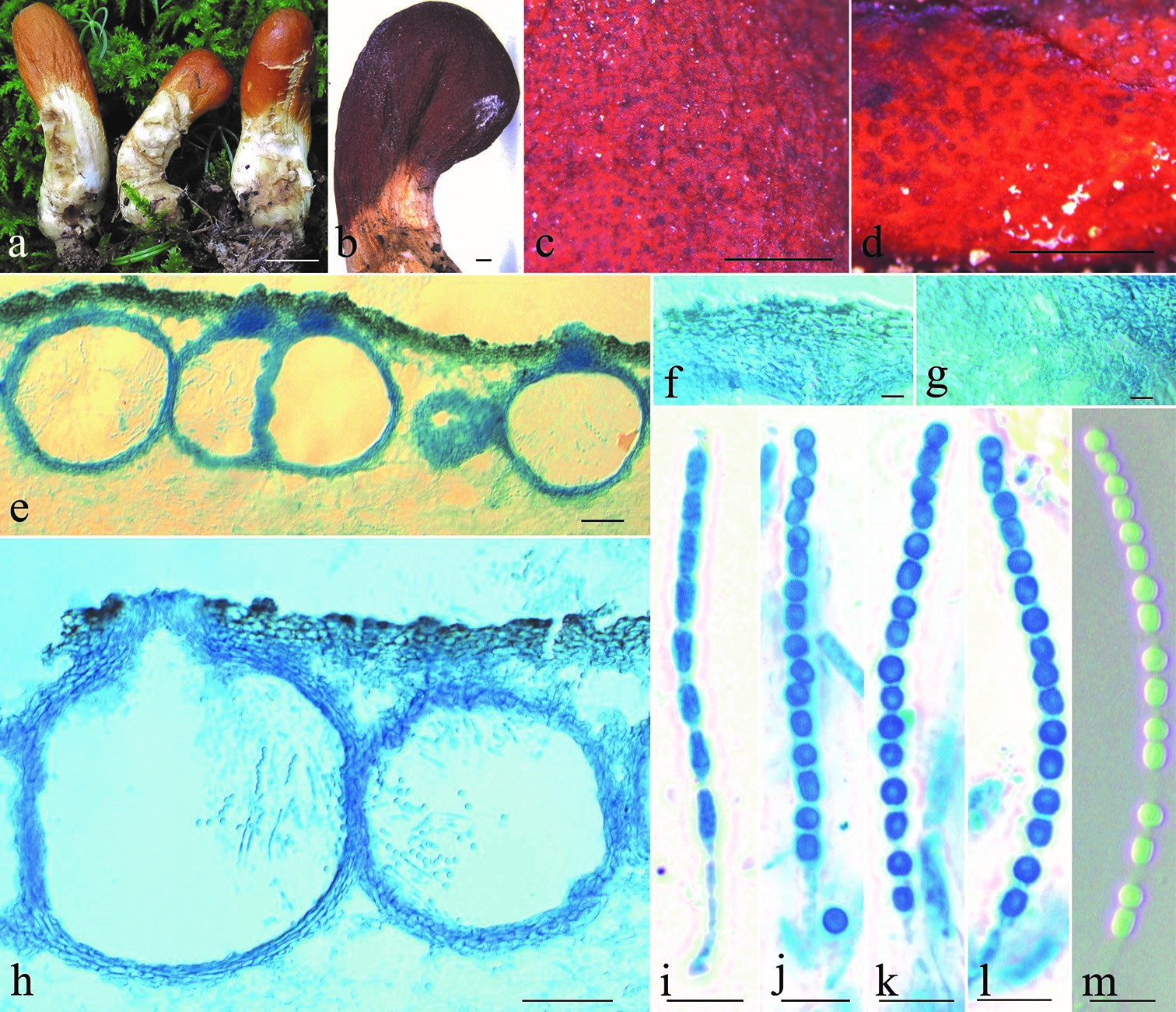 193
193
Trichoderma gansuanum Z.Q. Zeng & W.Y. Zhuang, sp. nov.
2020
Fungal Names: FN 570730
Holotype: China. Gansu Province, Shandan, Yanzhishan, on mossy humus, 25 Au gust 2018, Z.Q. Zeng, H.D. Zheng & X.C. Wang 12100 (HMAS 279687).
Morphological description
Stromata simple, rare dichotomously branched, clavate, 20–54 mm long. Fertile part clavate, 5–18 mm long, 1.2–4 mm wide at apex, only slightly broader than stipe, distinctly laterally compressed or longitudinally furrowed, gradually tapered downwards, reddish brown to brownish orange, KOH+; sterile part 15–36 mm long, 1–3 mm wide, beige to cream KOH+. Stromatal surface slight tuberculate from papillate perithecial elevations. Ostiolar openings visible, 30–58 μm high. In section, cortical tissue of textura angularis,15–35 μm thick, cells hyaline to light yellow, 5–15 × 2–3 μm; subcortical tissue of textura angularis, 8–28 μm thick, cell hyaline to light yellow, 8–15 × 3–5 μm; subperithecial tissue of textura epidermoidea, rare textura angularis, cells hyaline to light yellow. Perithecia globose to subglobose, 196–206 × 167–235 μm; peridium 8–18 μm thick at flanks, 9–20 μm thick at the base. Papilla prominent, blunt or truncate, brown, 15–35 μm high, 18–43 μm wide at the base. Asci subcylindrical, 50–80 × 3–4 μm. Part-ascospores green, spinulose, dimorphic, distal cells globose, rarely ellipsoidal, 2.5–4 × 2.5–4 μm; proximal cells ellipsoidal to oblong, 3–5.5 × 2.5–3 μm. Asexual state unknown.
Habitat: on mossy humus
Distribution: China.
GenBank Accession: RPB2 MT087287; TEF1 MT095060
Notes: Among the known stipitate species of Trichoderma, T. gansuanum resembles T. nybergianum in habitat and having simple, clavate, erect stromata, cylindrical asci and disarticulating ascospores (Chamberlain et al. 2004). Trichoderma gansuanum differs from the latter in shorter ascomatal stipe (20–54 mm vs 22–220 mm long), smaller perithecia (196–206 × 167–235 μm vs 180–450 × 65–315 μm), asci (50–80 × 3–4 μm vs 63–130 × 3.2–7.5 μm), and part-ascospores (distal: 2.5–4 × 2.5–4 μm vs 3–6 × 3–4.5 μm; proximal: 3–5.5 × 2.5–3 μm vs 3–6 × 2.5–4.5 μm) (Chamberlain et al. 2004). Sequence comparisons reveal that there are 25 bp and 16 bp divergences between the two species in the regions of RPB2 and TEF1. Both morphological and molecular data support distinguish them at the species level. The asexual state of T. gansuanum remains unknown until a culture is available.
Reference: Zeng Z-Q, Zheng H-D, Wang X-C et al. (2020) Ascomycetes from the Qilian Mountains, China
Trichoderma gansuanum a fresh stroma b dry stroma c stromatal surface d color of stroma after rehydration e median section through stromata f cortical tissue in section g subperithecial tissues in section h perithecia in section i ascus with ascospores j–m ascus with part-ascospores a from HMAS 279684, b–m from HMAS 279687. Scale bars: 1 cm (a); 1 mm (b–d); 50 μm (e–f); 10 μm (g–m).

